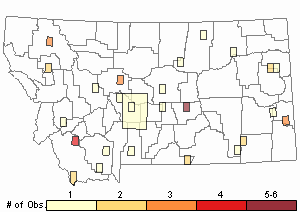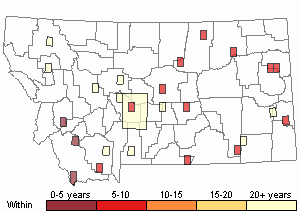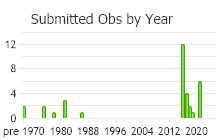View in other NatureServe Network Field Guides
NatureServe
Montana
Utah
Wyoming
Idaho
Wisconsin
British Columbia
South Carolina
Yukon
California
New York
A Fern Moss - Hypnum vaucheri
General Description
Plants: Pleurocarpous (Vitt 1988), typically growing in dense cushions or interwoven mats, green with yellow or brown tones (Lawton 1971). Stems prostrate to nearly upright, erratically to a little more regularly pinnate, 3-6 cm, ochre; branches 3-15 mm in length, growing initially in one plane; hyalodermis lacking and central strand in attendance; pseudoparaphyllia wide and leafy, few (FNA 2014); cortical stem cells little and with thick walls (Lawton 1971).
Stem Leaves: Upright to curved in sickle-like fashion and turned in one direction, 1.2-1.5 mm in length, to 0.5 mm in width (FNA 2014), cupped below (Lawton 1971), egg-shaped to widely lance-shaped with oblong tendencies, slowly or abruptly tapering to the somewhat short acumen (FNA 2014), the base longer than the acumen (Lawton 1971), not lobed (FNA 2014); leaf edges mostly flat (Lawton 1971) or widely curved back and down to almost flat at the base, almost smooth to finely saw-toothed above; costa with 2 branches; branch leaves akin to stem leaves (FNA 2014).
Leaf Cells: Laminal cells not papillose; medial laminal cells longer and a little narrower than the basal cells, frequently somewhat short and shaped like an ellipse particularly in straight leaves (FNA 2014), frequently porose (Lawton 1971); basal laminal cells porose, not colored; alar cells not colored (FNA 2014), square, the alar area large, usually with 12-15 cells along the margin, seldom reaching 25 (Lawton 1971), and well-delineated, sometimes with several inflated cells at the basal edge (FNA 2014).
Phenology
Fruit ripens in late summer and early autumn (FNA 2014).
Diagnostic Characteristics
The most dependable characteristic that distinguishes the similar Hypnum cupressiforme from Hypnum vaucheri may be its lance-shaped to filamentous pseudoparaphyllia; those of H. vaucheri are leafy with dull ends (FNA 2014).
Range Comments
North American Range
Canada: YT to NU, BC to NL; USA: AK, ND to TX and west from that line to the coastal states (except KS, OK, OR and ID), also MN, AR, and NY; Mexico (FNA 2014). Known in Montana from Carter, Cascade, Custer, Fallon, Fergus, Gallatin, Garfield, Golden Valley, Lake, Madison, McCone, Meagher, Park, Powder River, Richland, Roosevelt, Rosebud, and Valley Counties (Elliott and Pipp 2016).
Observations in Montana Natural Heritage Program Database
Number of Observations: 45
(Click on the following maps and charts to see full sized version)
Map Help and Descriptions
Relative Density

Recency



 (Observations spanning multiple months or years are excluded from time charts)
(Observations spanning multiple months or years are excluded from time charts)
Habitat
Open habitats, stone or soil (usually basic), bottoms of trees, soil, rotting wood. Occurring from lowlands to about 11,480 feet elevation (FNA 2014).
Reproductive Characteristics
Dioicous, rarely producing sporophytes. Exterior perichaetial bracts bent back and downward; interior perichaetial bracts upright with a thin acumen, pleated. Seta 10-15 mm tall, somewhat red or yellow, smooth. Capsule 1.8-2.2 mm in length, brown, tilted; operculum cone-shaped; exostome teeth 16, with a zigzag line on the outer face, fine lines or ridges below, and papillae above; endostome processes 16, similar in height as the teeth, keeled, cilia present. Calyptra hairless and draping hood-like (FNA 2014).
Stewardship Responsibility
References
- Literature Cited AboveLegend:
 View Online Publication
View Online Publication Elliott, J.C. and A.K. Pipp. 2018. A Checklist of Montana Mosses (1880-2018). Updated 3 January, 2020. Montana Natural Heritage Program, Helena, Montana. 73 pp.
Elliott, J.C. and A.K. Pipp. 2018. A Checklist of Montana Mosses (1880-2018). Updated 3 January, 2020. Montana Natural Heritage Program, Helena, Montana. 73 pp. Flora of North America Editorial Committee, eds. 2014. Flora of North America North of Mexico. Volume 28. Bryophytes: Mosses, Part 2. Oxford University Press, Inc., NY. xxi + 702 pp.
Flora of North America Editorial Committee, eds. 2014. Flora of North America North of Mexico. Volume 28. Bryophytes: Mosses, Part 2. Oxford University Press, Inc., NY. xxi + 702 pp. Lawton, E. 1971. Moss Flora of the Pacific Northwest. Hattori Botanical Laboratory. Japan: Yamabuki-cho, Shinjuku-ku, Tokyo. 362 pages plus appendices.
Lawton, E. 1971. Moss Flora of the Pacific Northwest. Hattori Botanical Laboratory. Japan: Yamabuki-cho, Shinjuku-ku, Tokyo. 362 pages plus appendices. Vitt, D. J. Marsh, and R. Bovey. 1988. Mosses, Lichens & Ferns of Northwest North America. Seattle, WA: University of Washington Press. 296 p.
Vitt, D. J. Marsh, and R. Bovey. 1988. Mosses, Lichens & Ferns of Northwest North America. Seattle, WA: University of Washington Press. 296 p.
- Additional ReferencesLegend:
 View Online Publication
View Online Publication
Do you know of a citation we're missing? Crum, H.A. and L.E. Anderson. 1981. Mosses of Eastern North America. 2 volumes. Columbia University Press, New York. 1328 pp.
Crum, H.A. and L.E. Anderson. 1981. Mosses of Eastern North America. 2 volumes. Columbia University Press, New York. 1328 pp. Elliot, J. C. 1993. Second checklist of Montana mosses. Unpublished report. U.S. Forest Service, Region 1. Missoula, MT. 45 pp.
Elliot, J. C. 1993. Second checklist of Montana mosses. Unpublished report. U.S. Forest Service, Region 1. Missoula, MT. 45 pp. Flowers, S. 1973. Mosses: Utah and the West. Brigham Young University, Provo, Utah. 567 p.
Flowers, S. 1973. Mosses: Utah and the West. Brigham Young University, Provo, Utah. 567 p. Lawton, E. 1971. Keys for the Identification of the Mosses on the Pacific Northwest. Reprinted from 'Moss Flora of the Pacific Northwest'. Published as Supplement No. 2 of the Journal of the Hattori Botanical Laboratory. Nichinan, Miyazaki, Japan. 66 pp.
Lawton, E. 1971. Keys for the Identification of the Mosses on the Pacific Northwest. Reprinted from 'Moss Flora of the Pacific Northwest'. Published as Supplement No. 2 of the Journal of the Hattori Botanical Laboratory. Nichinan, Miyazaki, Japan. 66 pp. Malcolm, B., N. Malcolm, J. Shevock, and D. Norris. 2009. California Mosses. Nelson, New Zealand: Micro-Optics Press. 430 pp.
Malcolm, B., N. Malcolm, J. Shevock, and D. Norris. 2009. California Mosses. Nelson, New Zealand: Micro-Optics Press. 430 pp. Smith, A.J.E. 1980. The Moss Flora of Britain and Ireland. Cambridge University Press, Cambridge. 705 pp.
Smith, A.J.E. 1980. The Moss Flora of Britain and Ireland. Cambridge University Press, Cambridge. 705 pp.
- Web Search Engines for Articles on "A Fern Moss"





